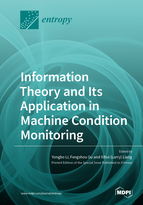Information Theory and Its Application in Machine Condition Monitoring
A special issue of Entropy (ISSN 1099-4300). This special issue belongs to the section "Multidisciplinary Applications".
Deadline for manuscript submissions: closed (15 November 2021) | Viewed by 25291
Special Issue Editors
Interests: information fusion; digital twin technology; structural health monitoring; fault diagnosis and prognosis; system reliability analysis; dynamic modelling of mechanical systems
Special Issues, Collections and Topics in MDPI journals
Interests: vibro-impact modelling; machine modelling and fault simulation; neural network modelling; time–frequency and time–scale analysis; modulation and demodulation analysis; complex vibro-acoustic source identification; acoustic condition monitoring; intelligent monitoring system; powerless and wireless data sensing and transfer; tribological dynamics
Special Issues, Collections and Topics in MDPI journals
Interests: nonlinear dynamics; condition monitoring; predictive maintenance; intelligent manufacturing
Special Issues, Collections and Topics in MDPI journals
Special Issue Information
Dear Colleagues,
Condition monitoring (CM) techniques have been rapidly advancing in recent years for promoting the productivity and reliability of large-scale engineering systems. This advancement is greatly impacted by the progress in information theory and computing technologies, evidenced by many published works in CM fields, such as Shannon entropy, Lempel-ziv complexity, and permutation entropy. As a statistical measure, information theory can be used to quantify complexity and detect dynamic change by taking into account the nonlinear behavior of time series. The information theory can be served as a promising tool to extract the dynamic characteristics of machines, which is useful in developing effective condition monitoring techniques.
The last decade has witnessed an increasingly growing research interest in information theory. This Special Issue aims to provide a platform to present high-quality original research as well as review articles on the latest developments of information theory and its application in machine condition monitoring.
Dr. Yongbo Li
Prof. Dr. Fengshou Gu
Dr. Xihui (Larry) Liang
Guest Editors
Manuscript Submission Information
Manuscripts should be submitted online at www.mdpi.com by registering and logging in to this website. Once you are registered, click here to go to the submission form. Manuscripts can be submitted until the deadline. All submissions that pass pre-check are peer-reviewed. Accepted papers will be published continuously in the journal (as soon as accepted) and will be listed together on the special issue website. Research articles, review articles as well as short communications are invited. For planned papers, a title and short abstract (about 100 words) can be sent to the Editorial Office for announcement on this website.
Submitted manuscripts should not have been published previously, nor be under consideration for publication elsewhere (except conference proceedings papers). All manuscripts are thoroughly refereed through a single-blind peer-review process. A guide for authors and other relevant information for submission of manuscripts is available on the Instructions for Authors page. Entropy is an international peer-reviewed open access monthly journal published by MDPI.
Please visit the Instructions for Authors page before submitting a manuscript. The Article Processing Charge (APC) for publication in this open access journal is 2600 CHF (Swiss Francs). Submitted papers should be well formatted and use good English. Authors may use MDPI's English editing service prior to publication or during author revisions.
Keywords
- information theory
- condition monitoring
- complexity measure
- symbolic dynamic analysis
- fault detection, diagnosis and prognosis
- dynamic change detection
- machine learning
- physics driven digital modeling
- multi-objective optimizations
- intelligent maintenance









